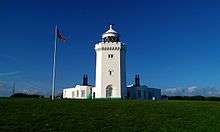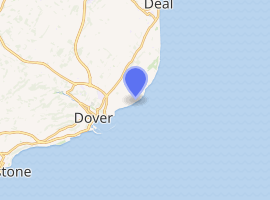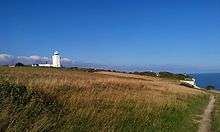South Foreland Lighthouse
South Foreland Lighthouse is a Victorian lighthouse on the South Foreland in St. Margaret's Bay, Dover, Kent, England, used to warn ships approaching the nearby Goodwin Sands. Built in 1843, it went out of service in 1988 and is currently owned by the National Trust. It is notable as having been the first lighthouse to use an electric light,[1] and was the site chosen by Guglielmo Marconi for his pioneering experiments in wireless radio transmissions.[2]
 South Foreland Lighthouse from the front | |
 | |

| |
| Location | South Foreland Dover Kent England |
|---|---|
| Coordinates | 51.14040°N 1.37110°E |
| Year first constructed | 1793 (first) |
| Year first lit | 1843 (current) |
| Deactivated | 1988 |
| Construction | stone tower |
| Tower shape | octagonal tower with balcony and lantern attached to keeper's house |
| Markings / pattern | white tower and lantern |
| Tower height | 21 metres (69 ft) |
| Current lens | 1st order revolving Fresnel lens |
| Characteristic | Fl W (3) |
| ARLHS number | ENG-087 |
| Heritage | National Trust owned |
The lighthouse was originally South Foreland Upper Lighthouse, one of a pair. The second lighthouse, South Foreland Lower Lighthouse was built at the same time further down the cliff, to the east, where it still stands; decommissioned in 1904, it is now in private ownership. Prior to the current buildings there had been a pair of lighthouses at South Foreland since at least the 1630s.[3] Even after the decommissioning of the Lower Lighthouse the pair continued to be used as leading marks, with Admiralty charts into the 20th century indicating that the 'Lighthouses in line lead south of the Goodwin Sands'.[4]
History
The dangers posed to shipping by the Goodwin Sands have long been recognised and the earliest record of a warning light being used on the Foreland relates to a Brother Nicholas de Legh, who hung a white light from cliffs near St Margaret-at-Cliffe a little to the north.[3]
17th and 18th century
.jpg)
The first pair of lighthouses at South Foreland was built in 1635 by Sir John Meldrum.[3] (He also built the first North Foreland Lighthouse, 15 miles to the north, the following year.) The light at this time was provided by an open fire burning in a brazier on the roof. Responsibility for the lighthouses (and rights to the associated light dues) were passed to a Robert Osboldston in 1643, and then in 1715 to Greenwich Hospital.
In 1730 one William Knott began a period of service as lighthouse keeper at the Lower Lighthouse. Over the next 175 years five generations of the Knott family would serve as lighthouse keepers at South Foreland, making them 'probably the longest dynasty of keepers anywhere in the world'.[5]
In 1793 the Upper Lighthouse was rebuilt with an oil lamp and parabolic reflectors in place of the brazier; the Lower Lighthouse was similarly rebuilt two years later (as a two-storey building, whereas the Upper Lighthouse was three storeys). John Yenn was the architect.[3]
19th century

In 1832 the Corporation of Trinity House purchased the lease for the South Foreland lights from Greenwich Hospital. Ten years later the Upper Lighthouse was heightened and refurbished with a multi-wick oil lamp and a first-order fixed dioptric optic, manufactured by Henry-Lepaute of Paris. Then, the Lower Lighthouse was entirely rebuilt, in 1846, and provided with a fixed array of fifteen Argand lamps and reflectors.[6] The architect and engineer for both these projects was James Walker.[7] At the same time new accommodation for the keepers was built alongside each tower.
Electric light
_p083_-_Plate_III._SouthForeland%2C_lanterns_and_lens.jpg)
In the 1850s Michael Faraday, scientific adviser to Trinity House, was exploring the feasibility of electric light being used in lighthouses; several different solutions were proposed. In 1857 Frederick Hale Holmes demonstrated his magneto-electric apparatus to Faraday, proposing its use in conjunction with carbon arc lamps. The initial trial was conducted at South Foreland Upper Light, which thus became the first lighthouse to use electric light.[8] The South Foreland trial began in December 1858 and continued until early 1860; afterwards Holmes's equipment was installed on a more permanent basis in Dungeness Lighthouse, in 1862. (Meanwhile, at South Foreland that year, experimental use was being made of a Drummond light at the high lighthouse; however, 'the results were not satisfactory' with regard to its potential for lighthouse illumination.[9])
_p075_-_Plate_I._South_Foreland%2C_general_plan_of_light-houses.jpg)
In 1871 Souter Lighthouse became the first to be designed and built for electric operation, and the following year South Foreland received its own permanent electric installation.[10] A power station was built, mid-way between the two lighthouses, containing four magneto generators driven by a pair of steam engines with coke-fuelled boilers. The building also included additional accommodation for the attendants. At the same time, the two lighthouses were each provided with a medium-sized (third-order) catadioptric fixed optic designed by James Chance.[11]
Experiments undertaken by John Tyndall
In 1865 John Tyndall had succeeded Faraday as scientific adviser to Trinity House, remaining in post until 1883.[12]
In 1873 Professor Tyndall was engaged by Trinity House to conduct a series of experiments on the relative effectiveness of different types of fog signal.[13] South Foreland, with its recently-installed steam power plant, was chosen as the location and a variety of acoustic instruments were set up at the top and bottom of the cliff, to be monitored from a Trinity House vessel offshore. At first three systems were tested: a steam whistle, an air whistle and a pair of air-powered brass trumpets with reeds (designed by Frederick Hale Holmes). Later, other designs of whistle were trialled, as well as a steam 'syren' (provided by Joseph Henry) and three types of gun (operated by gunners from Dover Castle). Tyndall's recommendation was that the siren should provide the standard fog signal at major landfall stations, with reeds judged suitable at some sites; by 1884 sirens were in use at 22 coastal stations and on 16 lightships.[13] Tyndall presented wider conclusions on the acoustic effects of different atmospheric conditions in a paper delivered to the Royal Society the following year.[14]
In 1876 Tyndall was again engaged to make a comparative study at South Foreland, this time of two different types of electric generator: the magneto and the dynamo.[15] (In 1869 Holmes had speculatively constructed a pair of dynamos and suggested them for the permanent South Foreland installation, but at the time they were not considered sufficiently tried and tested.) The trial took place over the winter of 1876-77, and the dynamo was demonstrated to be both mechanically and electrically superior. A set of Siemens dynamos was shortly afterwards installed at Lizard Lighthouse when it was converted to electrical operation in 1878.
Later, in 1884, Professor Tyndall again conducted experiments for Trinity House at South Foreland, this time on the relative merits of gas lamps, oil lamps and electric lamps. For this purpose three temporary lighthouses were built, at the top of the cliff alongside the Upper Lighthouse, one powered by oil, one by gas and the third by electricity.[16] Each provided space for different configurations of lamps or burners and optics to be tried. More than 6,000 observations were taken, from stations both on and offshore, and it was concluded that electric light was the most powerful under all conditions.[17]
Marconi
In 1898 South Foreland Lighthouse was used by Guglielmo Marconi during his work on radio waves, receiving the first ship-to-shore message from the East Goodwin lightship on Christmas Eve that year. The system was used over the following winter to avert several shipwrecks. In 1899, the first international transmission was made between the lighthouse and Wimereux in France.[18]
20th century

In 1904 the Lower Lighthouse was taken out of commission; the tower was sold and the attached cottage demolished soon afterwards. At the same time a large (first-order) rotating optic was installed in the High Lighthouse (this optic had previously been installed in St. Catherine's Lighthouse).[10]
The lighthouse was connected to mains electricity in 1922, whereupon South Foreland Lighthouse became the first to use an incandescent lightbulb as its light source.[10] The Holmes generators, which had provided power for fifty years, were then disconnected, and the Holmes arc lamp was given to the Science Museum.[19] The subsequent reduction of required maintenance, and provision of automatic electric equipment (including an electric winder for the clockwork mechanism to turn the lens), led to a reduction in staff numbers from one engineer and four keepers to just a single keeper.[20] In the event of a bulb failure, an automatic lamp changer was activated (and an alarm notified the keeper); if the reserve bulb then failed, the lamp changer caused an acetylene burner to be brought into position and lit.[20]
In 1969 the light became fully automated and the keepers' cottages (being no longer required) were sold.[21] In the mid-1980s it was decided that modern navigational aids had rendered the South Foreland light obsolete. It was decommissioned on 30 September 1988.[7]
Present day

The lighthouse has been in the ownership of the National Trust since 1989. As such it is open to the public. There is no vehicle access to the site; visitors are advised to walk either from Dover or from St Margaret's village, or else to use the nearby cycle route.[22]
The lighthouse had remained unlit since 1988, but in June 2012 the light was reactivated to mark the Diamond Jubilee of Elizabeth II. (The clockwork mechanism which turns the optic was restored to working order in 2004 to mark the centenary of its installation).[23]
Two lighthouses
Originally, there was another lighthouse further down towards the cliff edge to give a bearing on the leading lights principle when a ship was at the point where it could safely turn left into the Downs behind the sands or right to go safely around the Sands. They were both built in the 1840s. However, the Sands shifted over the following years until this bearing became dangerously inaccurate and so the lower light was taken out of service in 1910. It still survives as part of a private garden but is under threat from cliff erosion.
The destruction of Trinity House records during the last war has prompted considerable conjecture about this lighthouse's history because other source material is hard to find. Whilst beacons or votive lights may have existed from early times one of the first reliable references is found the Penny Magazine 19th Sept. 1835, pp365, and states that Charles I granted letters-patent to 'continue and renew' the lighthouses at the North and South Forelands to Sir John Meldrum. Presumably, a record exists, somewhere of an earlier bequest.
It is a fact that two lighthouses still stand here, but it is by no means certain why they were built. The popular leading lights theory lacks conviction, since turning to port or starboard upon lining up the two lights would not automatically lead to safe passage unless the navigator knew precisely how far the ship was from land. A stronger argument seems to be that ships coming from the north might line up the lights in order to determine when it was safe to turn in for Dover Harbour. Seamen sailing up the channel might use these lights, not as leading lights (as popular opinion has it), but simply as lights in transit when another bearing is needed to confirm position. It is also uncertain why two lights were built in 1840 to give a lead when a Trinity House lightship had been stationed at the South Sands Head since 1832 precisely for that purpose. Lieutenant John Hay (British Channel Piloting, 1850) lists many bearings in the Downs using churches, buildings, mills, castles, and the upper South Foreland lighthouse, but makes no mention of one using both South Foreland lighthouses. Greg Holyoake, in his book Deal:All in the Downs, in a seemingly well-researched chapter on lighthouses and lightships (p. 100) says two lighthouses were first built at the South Foreland to distinguish it from the North Foreland. He also suggests the two lights served as a transit. Elsewhere,(vide) the authoritative and comprehensive website: www.pharology.eu says;"...since one light could be confused with another just along the coast it became necessary to make one light distinguishable from another. This was achieved by having two lights at the South Foreland whilst only one was shown at the North Foreland."
Charts as far back as the 17th century show that the cyclic movement of the Sands was known. Although the chart of Robert Jager, 1629, (Shipwrecks of the Goodwin Sands, R & B Larne) may leave something to be desired in accuracy of the coastline, it seems to suggest that the South Sand Head was farther south than it was in the next century and that the Head was turning back upon itself in cyclic movement. Early in the eighteenth century the South Sand Head was still so far south that the chart of Charles Labelye, 1736, (Public Records Office) shows a number of bearings, one of which runs through the two lighthouses then in existence and unmistakably strikes the Head. Richard Larne (Shipwrecks of the Goodwin Sands) estimates the increase/decrease at 4000 feet a century. It would seem to have been a foolish act to build two lighthouses to cover a bearing that so soon would be useless even if new sites were selected. Less widely known is the fact that a lightship of sorts is said to have been stationed at the South Sands Head since Elizabethan times for the express purpose of guiding the fleet into the anchorage of the Downs, although evidence for this assertion is slim. How effective a primitive light vessel may have been is a matter of speculation.
In popular culture
- The South Foreland Lighthouse is one of the landmarks mentioned in the British sea shanty "Spanish Ladies".
- The ChuckleVision episode "Finders Keepers" was filmed here.
- The Doomwatch episode "The Red Sky" was filmed here.
- The Lower Lighthouse was featured in the 1967 film The Shuttered Room, which starred Gig Young, Carol Lynley, Flora Robson and Oliver Reed.
References
- "South Foreland Lighthouse: Features". National Trust. Retrieved 24 February 2019.
- "South Foreland Lighthouse: Gugliemo Marconi". National Trust. Retrieved 24 February 2019.
- "South Foreland Lighthouse: The History of the Lighthouse". National Trust. Retrieved 24 February 2019.
- "England South East Coast -- The Downs . . . Compiled From The Latest Information In The Hydrographic Department . . .London, 1898 (1917)". Barry Lawrence Ruderman Antique Maps Inc. Admiralty. Retrieved 2 March 2019.
- "South Foreland Lighthouse: The Knott Family". National Trust. Retrieved 24 February 2019.
- "Lighthouse management : the report of the Royal Commissioners on Lights, Buoys, and Beacons, 1861, examined and refuted Vol. 2". pp. 79–80.
- "South Foreland Lighthouse: The Current Lighthouse". National Trust. Retrieved 24 February 2019.
- Baird, Spencer Fullerton (1876). Annual record of science and industry. New York: Harper & Brothers. p. 460.
- Douglass, James Nicholas (13 June 1879). "Report from the Select Committee on Lighting by Electricity". Reports from Committees (House of Commons). 11: 54–61.
- "South Foreland". Lighthouses of England. Retrieved 24 February 2019.
- Chance, James Frederick (1902). The Lighthouse Work of Sir James Chance, Baronet (PDF). London: Smith, Elder & co. p. 166. Retrieved 24 February 2019.
- "Interactive Timeline of John Tyndall". Royal Institution. Retrieved 2 March 2019.
- Renton, Alan (2001). Lost Sounds: The Story of Coast Fog Signals. Caithness, Scotland: Whittles.
- Tyndall, John (1874). "On the Atmosphere as a Vehicle of Sound". Philosophical Transactions of the Royal Society of London. 164: 183–244. doi:10.1098/rstl.1874.0007.
- King, W. James (December 1963). "The Development of Electrical Technology in the 19th century - 3: the early arc light and generator". Bulletin of the Smithsonian Institution (228): 334.
- "Photo". St Margaret's Village Archive. Retrieved 2 March 2019.
- "Lighthouse Illuminants". Science. 16 (406): 267–269. 14 November 1890. JSTOR 1764997.
- Degna Marconi (1962). My Father Marconi. pp. 68–71.
- Catalogue entry (1923-169) and photo.
- Encyclopaedia Britannica, volume 14 (14 ed.). London: The Encyclopedia Britannica Company, Ltd, 1929. 1929. p. 96.
- "South Foreland Lighthouse: The End of an Era". National Trust. Retrieved 24 February 2019.
- "South Foreland Lighthouse: How to get here". National Trust. Retrieved 24 February 2019.
- "Soldiers bring light to cliffs". BBC News. Retrieved 24 February 2019.
External links
![]()